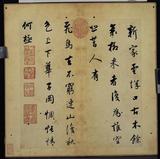元趙雍春郊遊騎圖 軸
推薦分享
資源連結
連結到原始資料 (您即將開啟新視窗離開本站)後設資料
- 資料識別:
- 故畫000224N000000000
- 資料類型:
- 繪畫
- 著作者:
- 趙雍
- 主題與關鍵字:
- 春景 高士(士人、隱士) 官員(臣) 馬
- 日期:
- TIME STAMP:27-9月 -05
- 格式:
- 本幅 88x51.1公分&全幅 95.1公分
- 關聯:
- 石渠寶笈初編(養心殿),上冊,頁659&故宮書畫錄(卷五),第三冊,頁165&故宮書畫圖錄,第四冊,頁205-206&趙雍,字仲穆,吳興人,為趙孟頫(1254-1322)次子。關於他的生年說法不一,但以世祖至元二十七年(1290)之說較為合理。他的書畫得自家傳,善山水,尤以人物、鞍馬為其所長。 趙雍承父風,工筆設色中略帶有文人趣味。其人馬圖,以至正十二年(1352)「駿馬圖」最佳,此幅「春郊遊騎」無紀年,構圖與繪於至正七年(1347)的「挾彈遊騎圖」 十分相似,皆畫一位穿著唐朝官服的貴族騎馬來到樹下,持弓上望。這種樹下人馬圖是唐代所流行之構圖,畫法亦承唐人青綠,色彩穠麗。此幅人物生動自然,馬匹肥碩雄壯,都以中峰鉤畫,線條謹密流暢,背景極為簡單,僅是兩株相抱的樹木,樹石亦用近似圖案的形式描繪,有高古簡逸的意趣。(童文娥) &趙雍(西元一二八九年生,卒年不詳),字仲穆,浙江吳興人。孟頫子,以書畫知名,畫尤以人物、鞍馬為所長。 本幅畫樹下遊騎一人,手中拿著弓,正轉頭回顧。人物形態生動自然,馬匹肥大雄壯,都以中鋒金勾畫,線條謹密流暢。背景極為簡單,僅是兩株相抱的樹木,樹葉以近似圖案的形式描繪,有古拙之意。作者似乎在追求著高古簡逸的趣味。&Chao Yung (style name Chung-mu) was a native of Wu-hsing, Chekiang. The son of Chan Meng-fu (1254-1322), he also achieved fame in painting and calligraphy. He was especially known for his representations of figures and saddled horses. In this painting, Chao Yung has depicted a man on horseback under a tree. The form of the figure is represented with vitality and naturalness; the horse is sleek and muscular. Both are drawn with fine lines created with a centered brush. The surrounding scenery is extremely simple, consisting merely of a horizon line and a pair of intertwined trees. The foliage, which fills the upper half of the painting, is drawn with an archaic awkwardness, as though the artist were consciously seeking to create an echo of antiquity imbued with a sense of simplicity and naïveté.
- 管理權:
- 國立故宮博物院
授權聯絡窗口
- 國立故宮博物院圖像授權、出版授權、影音資料授權-申請流程說明
http://www.npm.gov.tw/zh-TW/Article.aspx?sNo=03003061






